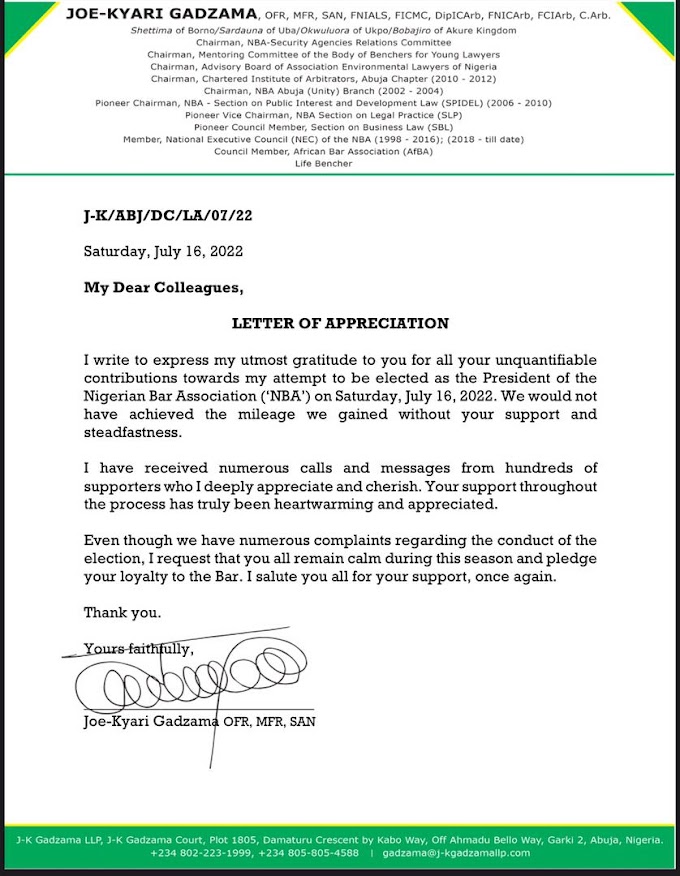ISSUE: CIRCUMSTANTIAL EVIDENCE-When circumstantial evidence will be deemed sufficient proof beyond reasonable doubt of the guilt of the accused
PRINCIPLE:
"I have stated that the proof of guilt of the accused person by the prosecution may either be done by the voluntary confession of the accused, through direct credible and reliable eye witness account or through circumstantial evidence pointing on the guilt of the accused. In other words, where there is no eye witness a count or direct evidence of the commission of an offence, a conviction may be based on circumstantial evidence.
There is no yardstick by which any circumstantial evidence can be measured before a conviction can be entered against an accused person. Thus, each case depends on its own facts. However, one test which such evidence must satisfy is that it should lead to the guilt of an accused person and leave no degree to possibility or chance that other persons could have been responsible for the commission of the offence.
The absence of direct evidence is indeed the very essence of resort to circumstantial evidence. Thus the Court may infer from the facts proved the existence of other facts that may logically tend to prove the guilt of an accused person. See IDOWU V. STATE (1998) 11 NWLR (Pt. 574) 354. In IJIOFFOR V. STATE (2001) 9 NWLR (Pt. 718) 371, KARIBI-WHYTE, JSC, at Page 390, Paras. E - H said:
"There is no direct evidence of the fact that appellant gave the corrosive substance i.e. acid to the deceased.
But the circumstances of the fact that he had not wanted the deceased baby to be born, had earlier threatened to kill the baby, and on the day the child died had sent the children with him to go and buy a bottle of coke, when PW1 went into the back of the house to wash the soiled pant of the baby. This stratagem gave him sufficient opportunity to introduce the corrosive acid into mouth of the baby. On the facts before the Courts no other person had the opportunity to do so.
The evidence though indirect, is cogent, positive and compelling, pointing to appellant and no other person for the commission of the offence. It can be observed from the evidence before the Courts and construing the facts narrowly that the inevitable force of the circumstances lie in the unmistakable aim of the totality of the evidence which by an undersigned coincidence points in the direction of the guilt of the accused."
In the instant case, there is no direct evidence of the fact that the appellant aided the kidnappers to
kidnap PW2 and PW3 but the circumstances of the fact that appellant prophesied that kidnappers were invading PW1's house and while pretending to pray, the kidnappers came to the house in matters of minutes points to the guilt of the appellant. There was also the evidence of the appellant's insistence that the prayers be held in the kitchen as against doing it in the parlour as earlier suggested by PW1. Furthermore, when PW1's wife wanted to lock the kitchen door, the appellant refused. Alas, the kidnappers made their way into PW1's house through the kitchen. The above facts are clearly incompatible with the appellant's denials and his innocence.
Appellant has not given any evidence of co-existing circumstances which can weaken the inference of the trial Court which in my view properly appraised the circumstantial evidence adduced by the prosecution before convicting the appellant.
Where as in this case, the trial Court had properly evaluated the evidence before it before ascribing probative value to it, an appellate Court can not and should not disturb such an exercise. See ARCHIBONG V. AKPAN (1992) 4 NWLR (Pt. 238) 750; RABIU V. KURE (2010) ALL FWLR (Pt. 539) 1070; ABDULMUMINI V. FRN (2918) 13 NWLR (Pt. 1635) 106 at 120.
I am therefore not in the slightest doubt that the circumstantial evidence in this case has proved beyond reasonable doubt that the appellant aided the kidnap of PW1's children and therefore the first issue is resolved against the appellant." Per SHUAIBU, JCA.(Pp.18-22,Paras.D-A).
ESSEYIN vs. THE STATE(2018)LPELR-44476(SC)
ISSUE: CIRCUMSTANTIAL EVIDENCE-Conditions that must be met before a conviction can be sustained by circumstantial evidence
PRINCIPLE:
"The law is settled that a conviction may be based on circumstantial evidence if it is such that it makes a complete unbroken chain of evidence pointing irresistibly to the conclusion that the accused person and no other committed the offence. The evidence must be such as to leave no room for speculation. See: Peter vs. The State (1997) 12 NWLR (Pt. 531) 1; Adesina & Anor. vs. The State (2012) 14 NWLR (Pt. 1321) 429; State vs. Ogbubunjo (2001) 13 NWLR (Pt. 685) 464; Lori & Anor. vs. The State (1980) 8 - 11 SC 81." Per KEKERE-EKUN, JSC.(P.18,Paras.A-D).







0 Comments